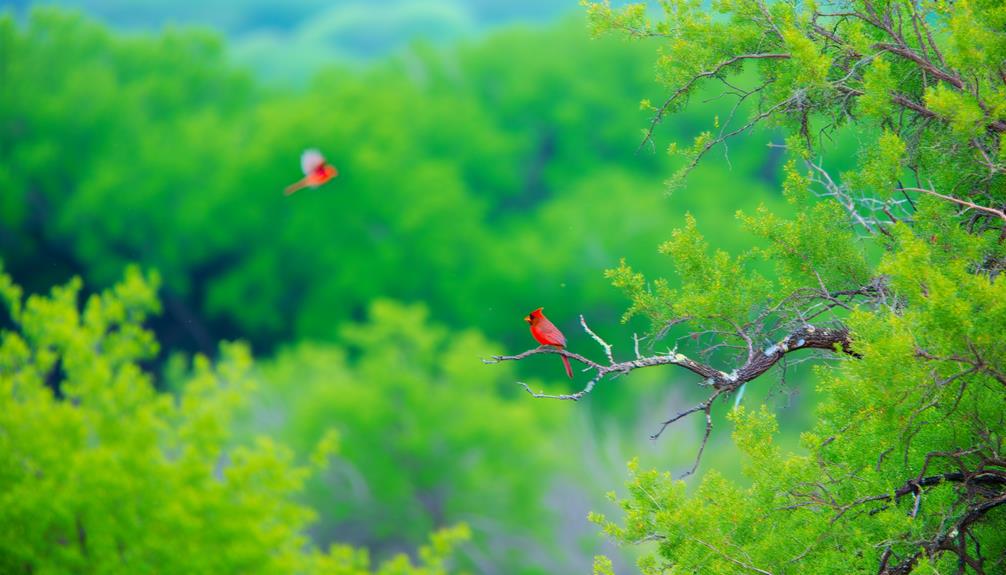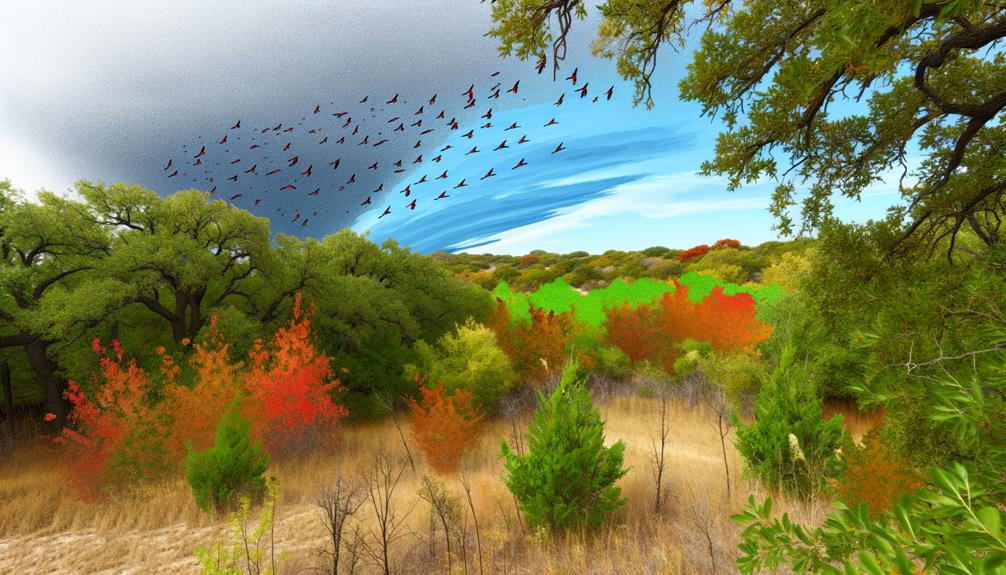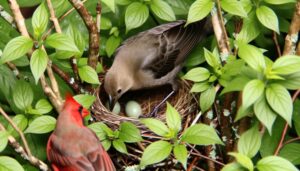Do Cardinals Migrate from Texas?
Cardinals in Texas don't migrate much due to its mild climate and abundant food sources. In this region, they exhibit territorial behavior, defend nesting areas, and maintain stable body temperatures with minimal movement.
Their diets adapt to seasonal changes, consisting of seeds, fruits, and insects. You'll observe cardinals in dense shrubbery and low tree branches, especially during early mornings when they're most active.
They play an essential role in the ecosystem, controlling insect populations and enriching soil quality. Keep exploring if you seek a deeper understanding of their behaviors and ecological significance.

Key Takeaways
- Texas' mild climate leads to minimal winter migration for cardinals.
- Non-migratory cardinals adapt well to the Texan climate.
- Environmental factors like temperature and food availability influence cardinal migration patterns.
- Stable body temperatures are maintained through reduced movement in Texas.
- Cardinals' breeding season in Texas sees increased vocalizations and nesting activities.
Cardinal Behavior Overview

Cardinals exhibit a range of behaviors including territoriality, distinct vocalizations, and specific feeding habits that are crucial for their survival and reproduction.
You'll notice that males fiercely defend their territories, especially during the breeding season, using both song and physical displays.
Their vocalizations aren't just melodious; they're a crucial tool for communication, helping to establish territory boundaries and attract mates.
When it comes to feeding, cardinals primarily consume seeds, fruits, and insects, showcasing a versatile diet that supports their energy needs throughout the year.
By understanding these behaviors, you can better appreciate how cardinals adapt to their environment and secure their species' continuity.
These observations reveal the intricate interplay between behavior and survival in cardinal populations.
Seasonal Patterns in Texas
You should examine how Texas' seasonal variations influence cardinal behavior.
During winter, you'll notice that cardinals exhibit minimal migration due to the region's relatively mild climate.
In the breeding season, their activities intensify, with increased vocalizations and nest-building correlating with temperature changes and food availability.
Winter Migration Behavior
During winter, many bird species exhibit a range of migration behaviors, but Northern Cardinals in Texas generally remain resident throughout the colder months.
You'll find that these non-migratory birds adapt well to the Texan climate, displaying territorial fidelity. They often frequent feeders, taking advantage of available food sources like sunflower seeds.
By conserving energy through reduced movement, cardinals maintain stable body temperatures. Their plumage provides effective insulation against colder temperatures.
You might notice that both males and females exhibit increased foraging activity, essential for sustaining energy levels during shorter daylight hours. Additionally, cardinals may form loose flocks, enhancing survival through communal roosting.
Their ability to thrive in diverse habitats ensures they remain a constant presence in Texan landscapes year-round.
Breeding Season Activities
As winter recedes, Northern Cardinals in Texas shift their focus towards breeding activities, with males becoming more territorial and vocal to attract mates and establish nesting sites. You'll notice several key behaviors:
- Territorial Singing: Males sing complex, melodious songs to delineate their territory and ward off rivals.
- Courtship Displays: Males engage in elaborate courtship rituals, including feeding females and showcasing vibrant plumage.
- Nest Building: Pairs collaboratively construct nests using twigs, grass, and other materials, strategically placing them in dense shrubs or low tree branches.
During this period, females lay 2-5 eggs per clutch, with incubation lasting about 11-13 days.
Observing these activities provides insights into the species' reproductive strategies and the intricate dynamics of avian social structures.
Local Climate Impact
Texas' seasonal climate variations greatly influence the behavior and migration patterns of Northern Cardinals. Temperature fluctuations and precipitation play important roles. During the spring and summer, increased temperatures and ample rainfall create ideal conditions for breeding and foraging. Cardinals are more active and vocal during these periods, taking advantage of the abundant food supply.
In contrast, in the fall and winter, cooler temperatures and reduced precipitation can lead to diminished food resources. Cardinals may increase their range locally but typically don't undertake long-distance migrations. Instead, they adapt by seeking out sheltered areas and reliable food sources.
Understanding these seasonal patterns can help you appreciate how cardinals maintain their presence in Texas' diverse climates year-round.
Influences on Migration

Several environmental factors greatly influence the migration patterns of cardinals from Texas. You'll find that these birds' movements aren't random but rather dictated by specific stimuli in their environment.
Temperature fluctuations and food availability play a significant role in shaping cardinal migration. Cardinals are sensitive to abrupt temperature changes, which can trigger their instinct to seek more stable climates. The length of daylight, known as photoperiod, affects their biological clocks, prompting changes in behavior and location. Increased predator presence can also force cardinals to migrate to safer areas.
Understanding these influences is pivotal for predicting migration patterns. By observing these factors, you can better appreciate how cardinals navigate their environment, balancing survival and reproductive success.
Habitat and Food Sources
You need to recognize that cardinals prefer nesting in dense, shrubby areas which provide abundant cover and protection.
Their diet changes seasonally, with a preference for seeds and grains in the winter and fruits and insects during the warmer months.
These habitat and food source preferences greatly influence their migratory behavior in Texas.
Preferred Nesting Areas
Cardinals prefer dense thickets and forest edges for nesting, where they can find ample cover and abundant food sources like seeds, fruits, and insects. You'll often spot them constructing nests in areas that offer:
- Thick Vegetation: Provides protection from predators and harsh weather.
- Close Proximity to Water: Ensures a steady water supply, essential for hydration and food availability.
- Varied Plant Life: Supports a diverse diet and attracts necessary insects.
These habitats allow cardinals to thrive by offering the necessary resources for breeding and raising their young. The preference for such areas demonstrates their adaptability and careful selection for optimal survival conditions.
Seasonal Diet Changes
As seasons alter, the cardinal's diet changes to mirror the availability of different food sources within their selected habitats. During spring and summer, you'll observe cardinals feasting on insects such as beetles, grasshoppers, and caterpillars, which provide essential protein for breeding.
In fall and winter, their diet shifts to seeds and berries, including sunflower seeds, dogwood berries, and wild grapes, vital for sustaining energy during colder months. Cardinals display dietary plasticity, allowing them to exploit various ecological niches. This adaptability guarantees their survival across diverse habitats and changing seasons.
Observing Cardinals Locally

In Texas, keen birdwatchers often spot Northern Cardinals flitting among dense shrubs and low tree branches, particularly during the early morning hours. You'll find their vivid red plumage unmistakable against the greenery.
To maximize your chances of observing these beautiful birds, consider the following:
- Timing: Early morning is prime time for activity as cardinals are most vocal and visible.
- Habitat: Look near dense shrubbery and wooded areas; cardinals prefer these for nesting and feeding.
- Equipment: Use binoculars and a field guide to help identify and learn more about their behavior.
Impact on Ecosystem
Northern Cardinals play a significant role in Texas ecosystems by dispersing seeds and controlling insect populations, thereby contributing to the health and diversity of their habitats.
You'll notice that cardinals consume a variety of fruits and berries, aiding in seed dispersal through their droppings. This process promotes plant diversity and forest regeneration.
Additionally, cardinals help regulate insect populations by feeding on pests like beetles and caterpillars. Their predation helps maintain a balanced ecosystem and reduces the need for chemical pesticides.
By observing these behaviors, you can appreciate the cardinals' ecological significance. Their activities enhance soil quality and plant growth, fostering a robust environment.
Your understanding of these dynamics underscores the essential role Northern Cardinals play in ecosystem sustainability.
Conclusion
In Texas, you'll notice that cardinals don't typically migrate, staying put even during harsh conditions. Notably, about 60% of cardinal sightings occur in residential areas, highlighting their adaptability.
This statistic underscores their role in local ecosystems, where they help control insect populations and disperse seeds. Your backyard might be an essential habitat for these vibrant birds.
By providing food and shelter, you're supporting not just the cardinals, but the entire ecological balance.






